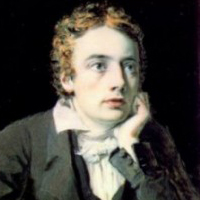Le Belle Dame Sans Merci by John Keats: Summary and Analysis
Le Belle Dame Sans Merci by John Keats is a narrative poem which means the beautiful lady without mercy. It is composed in the spring of 1819, is an exquisite ballad, recapturing, as it does, the simplicity, the spontaneity, the directness, the vividness, and the graphic force of the ancient models. It is John Keats’s finest ballad in English literature. Le Belle Dame Sans Merci is a ballad, a form of medieval art, which is revived by John Keats.

John Keats (1795-1821)
He uses a number of the stylistic features of the ballad, such as simplicity of language, repetition, and the absence of details and supernatural elements. The title is taken from a medieval French poem by Alain Chartier in which the speaker is mourning his dead mistress.
The poem narrates a sad and tragic love, betrayal of a mortal being who falls in love with a fairy. Just as the knight in the poem could not get the love of his beloved fairy, Keats also could not get success in love with Fanny. In this sense, this poem to some extent is an autobiographical poem.
The poem narrates a story of a knight's disappointed love with a fairy who is a mysterious lady. Once a knight was wandering about in a sad and dejected mood by the side of the lake. Someone or the poet asked the knight why he was so pale and haggard. The knight replied that he had met a beautiful lady in the meadows and was fascinated by her looks and beautiful features. She also fell in love with him. They both rode on a horseback, till they reached the cave of the fairy. There the lady expressed her love for him and lulled him to sleep. He saw a dream. In the dream he saw pale kings and warriors. All of them told him that the beautiful lady without mercy had captivated him. Their manner of warning terrified him. He woke up. Instead of finding himself in the cave of his lady-love, he found himself by the side of the hill. This was the reason why he was pale and haggard. Frustration in love made him sad, dejected, pale and haggard-looking.
It is a romantic ballad as much as it deals with the theme of love and also because it depends for its inspiration upon the medieval world of knights and elves, and of weird enchantment. The theme of a fatal, magical love luring a man to his doom is found in folk literature of the middle ages. The Romantic Movement revived an interest in such themes, and Keats succeeds in creating through an atmosphere of medieval romance a mood of psychological terror and desolation.
In La Belle Dame Sans Merci the Medieval revival reaches its culmination. The depth of passion which it expresses, or rather implies, the intense lyrical feeling, the exquisite art by which every detail of the weird landscape contributes to the general effect of mystery and of desolation, produce together an effect unequaled in the poetry of romance. It creates an atmosphere of the middle Ages with its atmosphere of enchantment, knight-errantry and the wasting power of love. The poem shows Keats's curious power of entering into the thought and sentiment of the middle Ages.
La Belle Dame Sans Merci is a literary ballad, that is, a poem written in imitation of a folk or traditional sense telling a story. But this ballad is not a mere literary experiment. It is in a sense a cry from the poet's heart, a tale of disillusionment told by a man whose dream of love has faded, leaving behind a taste dust and ashes in the mouth. The poem reminds us of Keats's bitter experience of the agony of love. He fell headlong in love with Fanny Browne, His ardent and hopeless passion for this woman is one of the most pathetic and poignant episodes in literary history. This poem, then, is not a mere literary experiment: it is 'a throne of the heart' of Keats.
Dramatic and narrative in form, it is in its spirit intensely lyrical, setting forth, under the guise of old-world symbols, the anguish and devastation of the poet's own soul. The poem is written in the traditional ballad stanza form of four lines. The first three verses in every stanza are iambic tetrameters; the last line of every stanza is an iambic diameter, with an occasional extra-syllable at the beginning. The poet used a single rhyme in each stanza, so that the second and the fourth lines rhyme. The first and third lines are left unrhymed.
La Belle Dame Sans Merci is an example of his disciplined art avoiding ornament which is in keeping with the simple ballad style. It is a superb example of the narrative art which has all the simplicity and directness of the best ballads. It is an instinct with keen imaginative power. Its weird intensity, the conciseness and purity of its poetic form, and the wild, yet simple magic of its beats-these lifts the poem into the region of great literature.
Cite this Page!
Sharma, K.N. "Le Belle Dame Sans Merci by John Keats: Summary and Analysis." BachelorandMaster, 8 Aug. 2017, bachelorandmaster.com/britishandamericanpoetry/le-belle-dame-sans-merci.html.
Related Topics
Ode to Autumn: Summary and Analysis
Ode on a Grecian Urn: Summary and Analysis
Ode to a Nightingale: Summary and Analysis
Ode to Psyche: Summary and Analysis
Ode on Melancholy: Summary and Analysis
Endymion: Summary and Analysis
The Eve of St. Agnes: Summary and Analysis
Bright Star: Summary and Analysis
On First Looking into Chapman's Homer: Analysis
The Terror of Death (When I have Fears): Analysis
 |
bachelorandmaster.com |